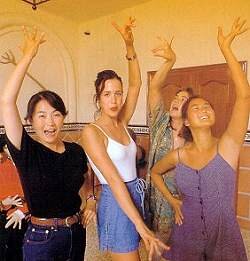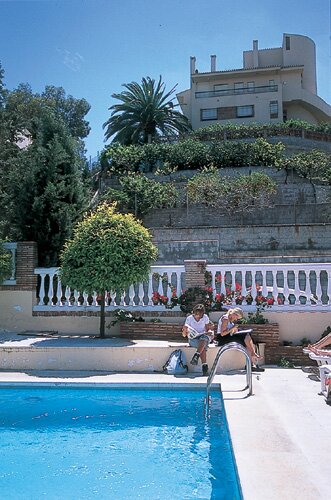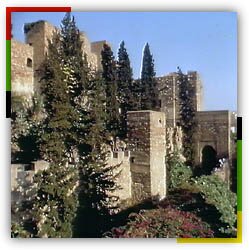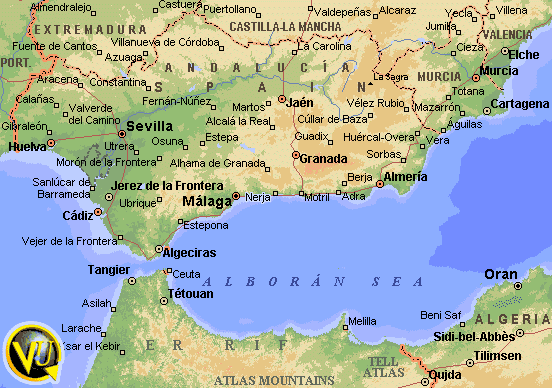
SPAIN : Malaga
|
Courses of 20 or 30 group lessons per week, commercial and business Spanish, preparation to DELE exam, special course for retired people, Spanish and dance, Spanish and cookery, Hispanic studies, Spanish mini group, academic year.
|
Our school includes several advantages. Indeed, it possesses everything, all in one. 20 spacious and very openwork classrooms provided with TV and video recorders, a multimedia studies centre, a library, a linguistic laboratory with all the material for the self - training and an access to Internet. Besides a cinema, a restaurant, a bar, 3 big very sunny terraces, a swimming pool. The school is in 15 minutes walking distance from the sea.
 Click here to see some pictures about the school Click here to see some pictures about the school
Tuition Programs
- Schedule:
20 lessons: 8:30 AM - 12:30 PM) and/or 4:00 PM - 8:00 PM.
30 lessons: 8:30 AM - 2:30 PM
- 1 lesson: 50 minutes
- Minimum age: 16
- All levels available
- Teaching material
- Language laboratory
- 10 students maximum per class
- Guided tour of the city
- Welcome party
- Activities organized by the school
- In this resort, you'll find a movie, a multimedia center, bar, cafeteria, dance studio, terrace and a swimming pool
- Commercial and businesses Spanish: minimum level required: intermediate, 30 lessons per week, 6 students per class, 2 weeks maximum.
- DELE exam exam preparation: 20 lessons per week, 4, 10, 14 or 16 weeks. The exam automatically follows the 4 weeks program.
- Spanish and dance: 2 or 4 weeks. 20 Spanish lessons and 10 dance lessons per week.
- Spanish mini group: 30 lessons per week, 6 students per class. For those who need very quick progress.
- Spanish for retired people (50 and up): 15 lessons per week, 2 weeks program, 1 excursion per week, 1 social and cultural activity every day. Tuition from 8:30 AM to 11: 30 AM.
- Hispanic studies: minimum level required: intermediate. 4 weeks. You'll study also Spain thru art, politics, culture, society
- Spanish and cookery: 2 weeks for "gourmets" people. 20 Spanish lessons per week, 1 dinner per week, 1 cultural activity on Spanish wines, 1 visit of gastronomic interest, 1 luxurious lunch in a famous and renown Andalusian table, cookery books, all transportation during your stay.
- Test and certificate of linguistic training


|
 |
Starting Dates
Courses of 20 or 30 lessons per week on the following days:
| January |
5(1)&,19 |
| February |
2&,16 |
| March |
1&**,15,29& |
| April |
12,26& |
| May |
10**,24 |
| June |
7**,21 |
| July |
5,19 |
| August |
2,16,30(2) |
| September |
13,27** |
| October |
11,25** |
| November |
8,22 |
| December |
6 |
** Business and commercial Spanish starts on these dates only.
& Dates for Hispanic studies
(1) (2) Academic year into 2 semesters
STR 1: January 5: 20 weeks
STR 2: August 30: 16 weeks
Private courses:
Every Monday, minimum 1 week Except on July and August, minimum 2 weeks (see dates above).
D.E.L.E. exam preparation:
| January |
5** |
| February |
2*** |
| April |
12* |
| August |
30**** |
| October |
11* |
* 4 weeks courses
** 18 weeks courses
*** 14 weeks courses
**** 10 weeks courses
Spanish for retired people will start on the following dates:
| Feb. |
March |
April |
May |
June |
Sept. |
Oct. |
Nov. |
| 16 |
1,15,29 |
12,26 |
10,24 |
7 |
13,27 |
11,25 |
8 |
Spanish and dance on the following dates
| January |
5*,19 |
| February |
2*,16* |
| March |
1*,15 |
| April |
12*,26* |
| May |
10,24 |
| June |
7* |
| September |
13,27* |
| October |
11*,25 |
* These dates are for the Salsa course.
All others are for "Sevillanas". For each month written above,
the 4 weeks start the first date shown. In that case only,
the first 2 weeks will be "Salsa" and the 2 last ones will be "Sevillanas".
Spanish and cookery
| April |
12 |
| May |
10 |
| June |
7 |
| September |
27 |
| October |
25 |
| November |
8 |
School closing Dates
| Jan. |
April |
August |
Sept. |
October |
Dec. |
| 6 |
8,9 |
16,19 |
8 |
12 |
6,8 |
The school will also be closed from Dec.18 to January 2, 2005.
Available options
- Airport transfer round trip: 50€
- Our prices are available from January 1st to December 31, 2004. These prices never include the Air Fare.
DELE: IMPORTANT NOTE
As every year the final dates of the exam will be fixed at the beginning of January by Instituto CERVANTES: it is strongly recommended to foresee an additional week for its residence with regard to foreseen dates. Here is
the minimum level required and the number of weeks wished to achieve either the level DELE INICIAL or INTERMEDIO ( BASICO).
INICIAL:
Complete beginner: 14 weeks
Beginning 2 ( A2) 10 weeks
Intermediary 2 ( B2) 4 weeks
INTERMEDIO ( BASICO)
Complete beginner: 18 weeks
Intermediary 2 ( B2) 10 weeks
Advanced 1 ( C2) 4 weeks
|
|
Family, student residence or shared apartment accommodation
- Arrival on Sunday
- Departure on Saturday
- Family, single or double occupancy, 2 meals per day.
- Apartment, shared with other students, no meal, single or double occupancy. Rental: from 2 weeks minimum.
- Residence at school, single or double * occupancy, no meal, private bathroom (shower or bath), swimming pool, cafeteria, 24/24 security. Superior rooms, all with a double bed, wide room, balcony, phone, TV, fridge.
* Pour 2 people travelling together.
Rates
| Program/ DAY *** |
1 |
| Family, single/double |
29€ / 26€ |
| Residence single/double |
26€ / 22€ |
| Residence, superior room, single/double |
60€ / 40€ |
| ///////////////////////////////////////////////// |
2 weeks |
additional week |
| Apartment, single occupancy |
205€ |
105€ |
| Apartment double occupancy (per person) |
135€ |
75€ |
* * * HIGH SEASON SUPPLEMENT : 4€ PER DAY FOR ALL ACCOMMODATION FROM JUNE 27 TO SEPTEMBER 11, 2004
 Our greeting families are recruited with great care. Our greeting families are recruited with great care.
The criteria of selection are very rigorous and each
family must satisfy a precise schedule of conditions:
excellent morality, desire to communicate with their host,
satisfactory social standing. We should specify that
the families will only speak with you the language of
the country where you will be. It is the principle of
the immersion courses!
|
|
City information
BETWEEN THE SEA AND THE MOUNTAINS
 Located in Eastern Andalusia, the territory of Málaga is divided into two clearly differentiated landscapes: the marine littoral, the Costa del Sol, washed by the warm waters of the Mediterranean Sea; and the mountains, the southern part of the Penibética Mountain Range, made up by a succession of valleys and mountains. Located in Eastern Andalusia, the territory of Málaga is divided into two clearly differentiated landscapes: the marine littoral, the Costa del Sol, washed by the warm waters of the Mediterranean Sea; and the mountains, the southern part of the Penibética Mountain Range, made up by a succession of valleys and mountains.
The coastal area enjoys a privileged Geographical position: protected from the North winds by the mountains, it benefits from the highest average temperatures in Spain and over 300 days of sunlight per year. Rugged and irregular in the eastern part, with rocky projections of land that penetrate the sea, it is milder and sandier in the western area, with large beaches that make it one of the most developed parts of Andalusia, thanks to its demographic and tourist appeal.
Although the mountains are not very high (the Sierra de Tolox has the highest peaks, just under 2.000 m), the steep mountain ranges of Málaga make up a very attractive natural landscape which includes the Serranía de Ronda to the West, reaching the Gibraltar Rock; the Torcal de Antequera, a unique natural area, in the centre; and the Tejeda and Almijara Mountain Ranges to the East, acting as a natural boundary between the provinces of Málaga and Granada, and including the beautiful Sierra de Alcaucín.
Located in one of the most important and ancient communication routes in Europe (the Straight of Gibraltar) and isolated from the rest of Spain by the Penibética Mountain Range, Málaga has been a place of settlement for many peoples since ancient times: the Phoenicians cave it its current name, the Greeks established flourishing colonies (Mainake, Torre del Mar) and the Romans made it a part of their empire. But it was Arab rule, lasting until the latter years of the 15th century, which most contributed to the identity of Málaga. Muslim Malaga, the seat of a reino de Taifas (a faction of the caliphate of Córdoba which broke up in the 11th century) was part of the kingdom of Granada until the Catholic Kings incorporated it to the rest of Christian Spain (1487). The cosmopolitan character of its modern-day tourism was anticipated during the period of Muslim rule, when it had important Berber, Syrian, Italian, and Jewish colonies; in the 15th century the city of Málaga had a corn exchange for Genoan merchants and a Jewish quarter. In the 18th century, after trade with America became easier, Málaga entered a prosperous period thanks mainly to its seaport. The plentiful trade of wines, dry fruits and minerals fostered the settlement of English, German and French colonies, which have left their mark through some of the family names of the inhabitants. This stage of economic development continued in the 19th century with the introduction of an important iron and steel industry: Málaga bears the honour of having built the first Spanish blast furnace.
Afterwards the province withered into a long period of decline which did not begin to subside until the 1960s, when the tourist industry began to develop strongly, to the point where it is currently the province's major source of income.
 Today Málaga has a well-developed transportation network. The autovía del Sol (along national motorway 340, from Barcelona to Cádiz) is the main communication route in the Costa del Sol. The autovía de Andalucía (A-92), from Seville to Baza, features a branch going from Antequera to Málaga (the so-called autovía de Málaga) which splits into two roads right before entering the city, one to the western Costa del Sol and one to the eastern part. Today Málaga has a well-developed transportation network. The autovía del Sol (along national motorway 340, from Barcelona to Cádiz) is the main communication route in the Costa del Sol. The autovía de Andalucía (A-92), from Seville to Baza, features a branch going from Antequera to Málaga (the so-called autovía de Málaga) which splits into two roads right before entering the city, one to the western Costa del Sol and one to the eastern part.
Regarding air transportation, Málaga international airport services the entire Costa del Sol - there are Iberia information offices in all of the main tourist information centres.
Málaga has a RENFE train station, connecting the city to the national train network, as well as a coastal track from Málaga to Fuengirola that stops at Torremolinos, Benalmádena and the airport.
Regarding sea transportation, Transmediterránea has a regular line to Melilla in the North of Africa, and Málaga is one of the regular stops for most cruises in the Mediterranean.
Malaga weather forecast
|

